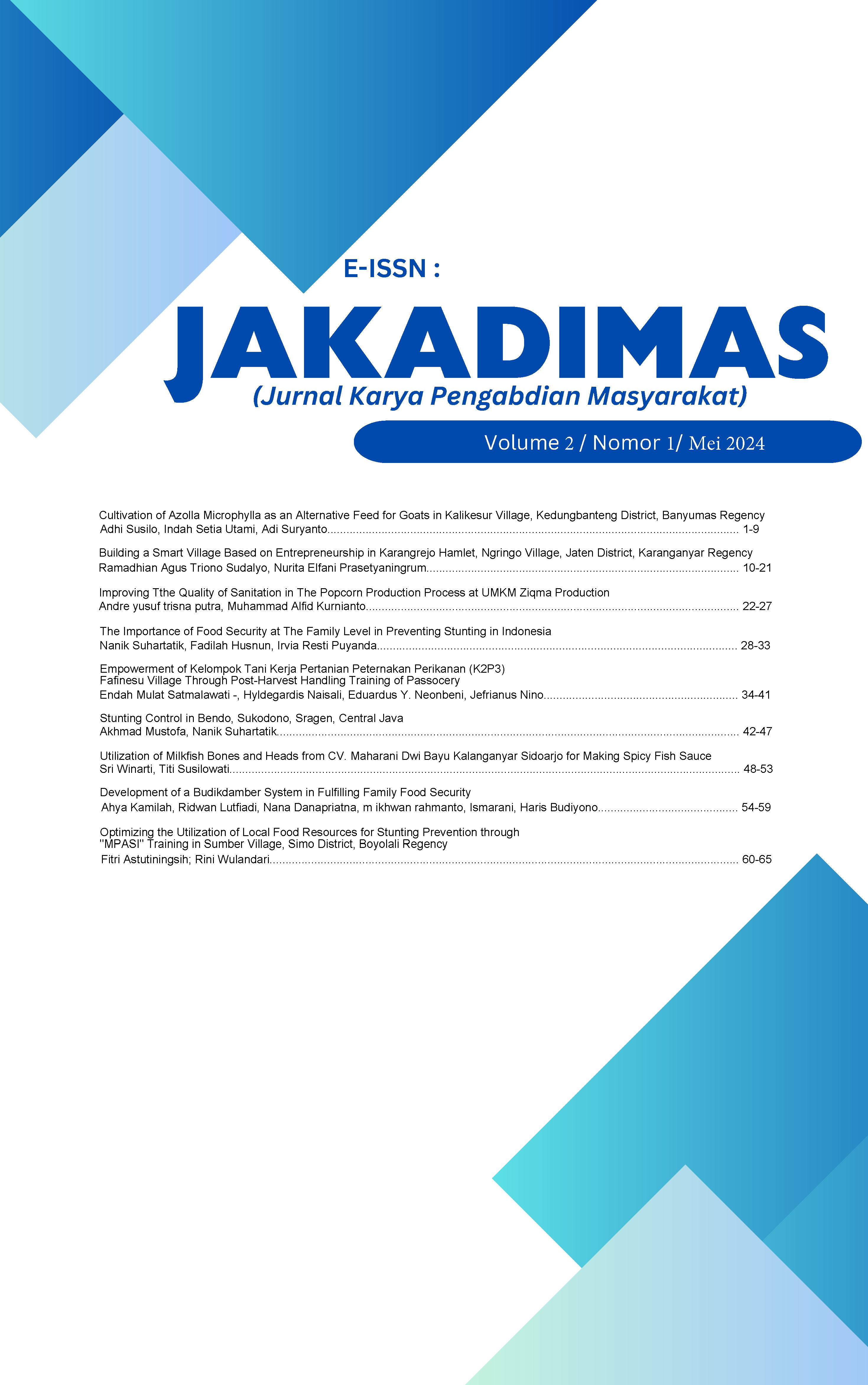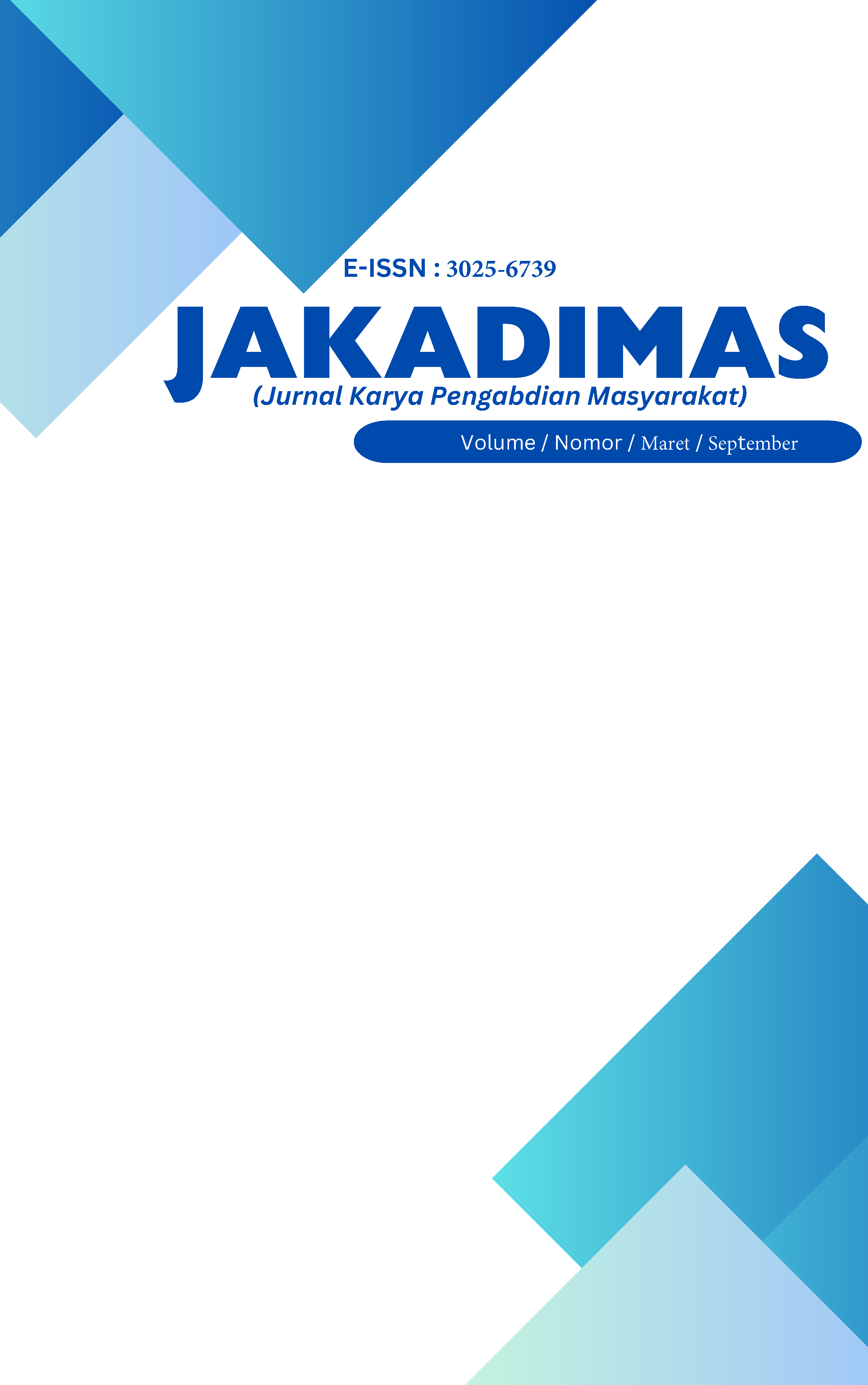The Importance of Food Security at The Family Level in Preventing Stunting in Indonesia
Pentingnya Ketahanan Pangan di Tingkat Keluarga dalam Pencegahan Stunting di Indonesia
DOI:
https://doi.org/10.33061/jakadimas.v2i1.10750Keywords:
Ketahanan pangan, MP-ASI, stuntingAbstract
Stunting is a condition where a child's height does not match the child's age. Stunting is used as an indicator of a child's growth process that is not good. Stunting is also used as an indicator of the achievements of a country's development process as outlined in the sustainable development goals (SDGs). Mojosongo Village is one of the sub-districts in Banjarsari District, Surakarta, Central Java. One of the sub-districts with still high stunting rates in Surakarta City. Handling of stunting in the City of Surakarta is carried out through several areas including economic, environmental, educational, facilities and infrastructure, and monitoring in the health sector. Based on the identification carried out, it was discovered that factor causing stunting is food availability at the family level or what is usually called food security. To support food security at the family level, one thing parents can do is provide food that is varied, nutritious and affordable for children. Efforts that can be made are by providing a varied menu as a complementary food for breast milk (MP-ASI). Fulfilling nutrition at the family level requires increasing family skills in providing healthy food, so it is necessary to provide training on MP-ASI processing for health cadres or parents. The training was carried out using lecture and direct practice methods and was attended by 46 participants consisting of health cadres in Mojosongo Village, UPPKB, and also parents. There are 4 high-protein processed ingredients provided, namely cheese potato sticks, milk corn pudding, macaroni schotel, and also soa noodles. Training participants, especially health cadres, gain knowledge and skills that are useful for preparing additional food (Pemberian Makanan Tambahan, PMT) for families of stunting sufferers.
References
Anugrahanto, N.C., 2023. Ikhtiar atasi Tengkes lewat program jamban sehat keluarga di Surakarta.https://www.kompas.id/baca/nusantara/2023/03/16/ikhtiar-atasi-tengkes-lewat-program-jamban-sehat-keluarga-di-Surakarta.
Crouse, M.S. et al. (2020) ‘The effects of maternal nutrient restriction and day of early pregnancy on the location and abundance of neutral amino acid transporters in beef heifer utero-placental tissues’, Journal of Animal Science, 98(7), pp. 1–10. Available at: https://doi.org/10.1093/jas/skaa197.
Divanruin, A., Nurhadi, N. and Pramanda, A. (2023) ‘Upaya Pencegahan Stunting Guna Mewujudkan Generasi Emas Indonesia Yang Berkualitas’, SEMANGGI : Jurnal Pengabdian kepada Masyarakat, 2(01), pp. 33–38. Available at: https://doi.org/10.38156/sjpm.v2i01.174.
Durao, S. et al. (2020) ‘Community-level interventions for improving access to food in low and middle-income countries (Review)’, Cochrane Database of Systematic Review, Wiley & Sons Ltd [Preprint]. Available at: https://doi.org/10.1002/14651858.CD011504.pub3.www.cochranelibrary.com.
Goudet, S.M. et al. (2019) ‘Nutritional interventions for preventing stunting in children (Birth to 59 months) living in urban slums in low-and middle-income countries (LMIC)’, Cochrane Database of Systematic Reviews, 2019(6). Available at: https://doi.org/10.1002/14651858.CD011695.pub2.
Harningsih, T. et al. (2023) ‘Penyuluhan Stunting dan Pemberian Makanan Tambahan bagi Keluarga yang Berhak di Kelurahan Pucangsawit, Jebres, Surakarta’, Jurnal Peduli Masyarakat, 5(1), pp. 13–16. Available at: https://doi.org/10.37287/jpm.v5i1.1509.
Kuchenbecker, J. et al. (2017) ‘Nutrition education improves dietary diversity of children 6-23 months at community-level: Results from a cluster randomized controlled trial in Malawi’, PLoS ONE, 12(4), pp. 1–19. Available at: https://doi.org/10.1371/journal.pone.0175216.
Mufida, L., Widyaningsih, T.D. and Maligan, J.M. (2015) ‘Prinsip Dasar Makanan Pendamping Air Susu Ibu ( MP-ASI ) untuk Bayi 6 – 24 Bulan : Kajian Pustaka.’, Jurnal Pangan dan Agroindustri, 3(4), pp. 1646–1651.
Nahar, B. et al. (2010) ‘Risk factors associated with severe underweight among young children reporting to a diarrhoea treatment facility in Bangladesh’, Journal of Health, Population and Nutrition, 28(5), pp. 476–483. Available at: https://doi.org/10.3329/jhpn.v28i5.6156.
Nauval, I., Ramadhani, V. and Zaelani, M. (2022) ‘Sosialisasi Program Pencegahan Stunting Dan Gizi Buruk Oleh Kkn Universitas Islam Batik Surakarta Di Desa Cetan Kecamatan Ceper Kabupaten Klaten’, SIDOLUHUR : Jurnal Pengabdian kepada Masyarakat., 2(02), pp. 168–176. Available at: https://journal.uniba.ac.id/index.php/jpm/article/view/503.
Rah, J.H. et al. (2015) ‘Household sanitation and personal hygiene practices are associated with child stunting in rural India: A cross-sectional analysis of surveys’, BMJ Open, 5(2). Available at: https://doi.org/10.1136/bmjopen-2014-005180.
Vaivada, T. et al. (2020) ‘Stunting in childhood: An overview of global burden, trends, determinants, and drivers of decline’, American Journal of Clinical Nutrition, 112, pp. 777S-791S. Available at: https://doi.org/10.1093/ajcn/nqaa159.
Yazew, T. (2022) ‘Risk Factors of Stunting and Wasting among Children Aged 6-59 Months in Household Food Insecurity of Jima Geneti District, Western Oromia, Ethiopia: An Observational Study’, Journal of Nutrition and Metabolism, 2022. Available at: https://doi.org/10.1155/2022/3981417.
Downloads
Published
How to Cite
Issue
Section
License
Copyright (c) 2024 Nanik Suhartatik, Fadilah Husnun, Irvia Resti Puyanda

This work is licensed under a Creative Commons Attribution-ShareAlike 4.0 International License.
Authors who publish with this journal agree to the following terms:
- Copyright on any article is retained by the author(s).
- The author grants the journal, right of first publication with the work simultaneously licensed under a Creative Commons Attribution License that allows others to share the work with an acknowledgment of the work’s authorship and initial publication in this journal.
- Authors are able to enter into separate, additional contractual arrangements for the non-exclusive distribution of the journal’s published version of the work (e.g., post it to an institutional repository or publish it in a book), with an acknowledgment of its initial publication in this journal.
- Authors are permitted and encouraged to post their work online (e.g., in institutional repositories or on their website) prior to and during the submission process, as it can lead to productive exchanges, as well as earlier and greater citation of published work.
- The article and any associated published material is distributed under the Creative Commons Attribution-ShareAlike 4.0 International License








